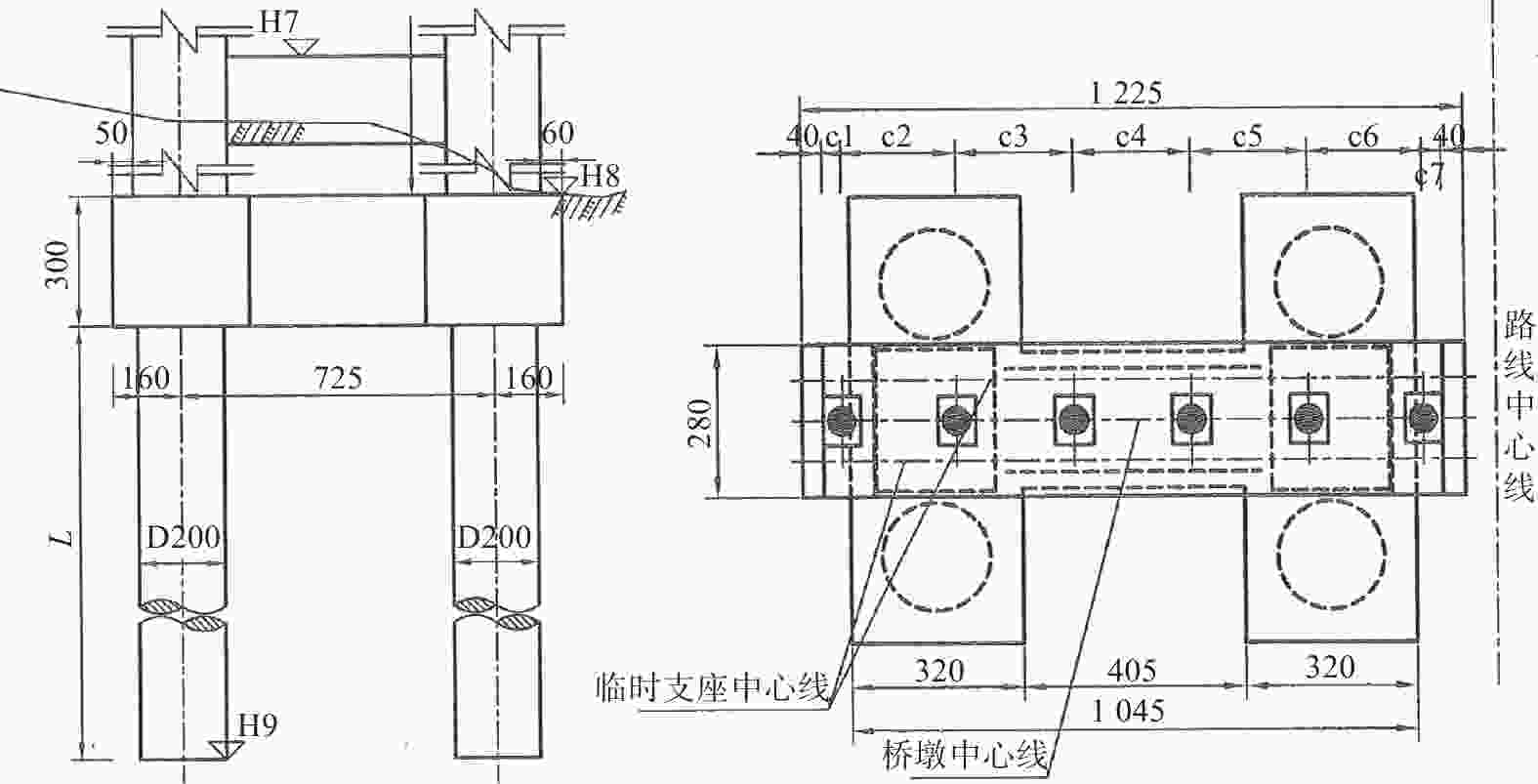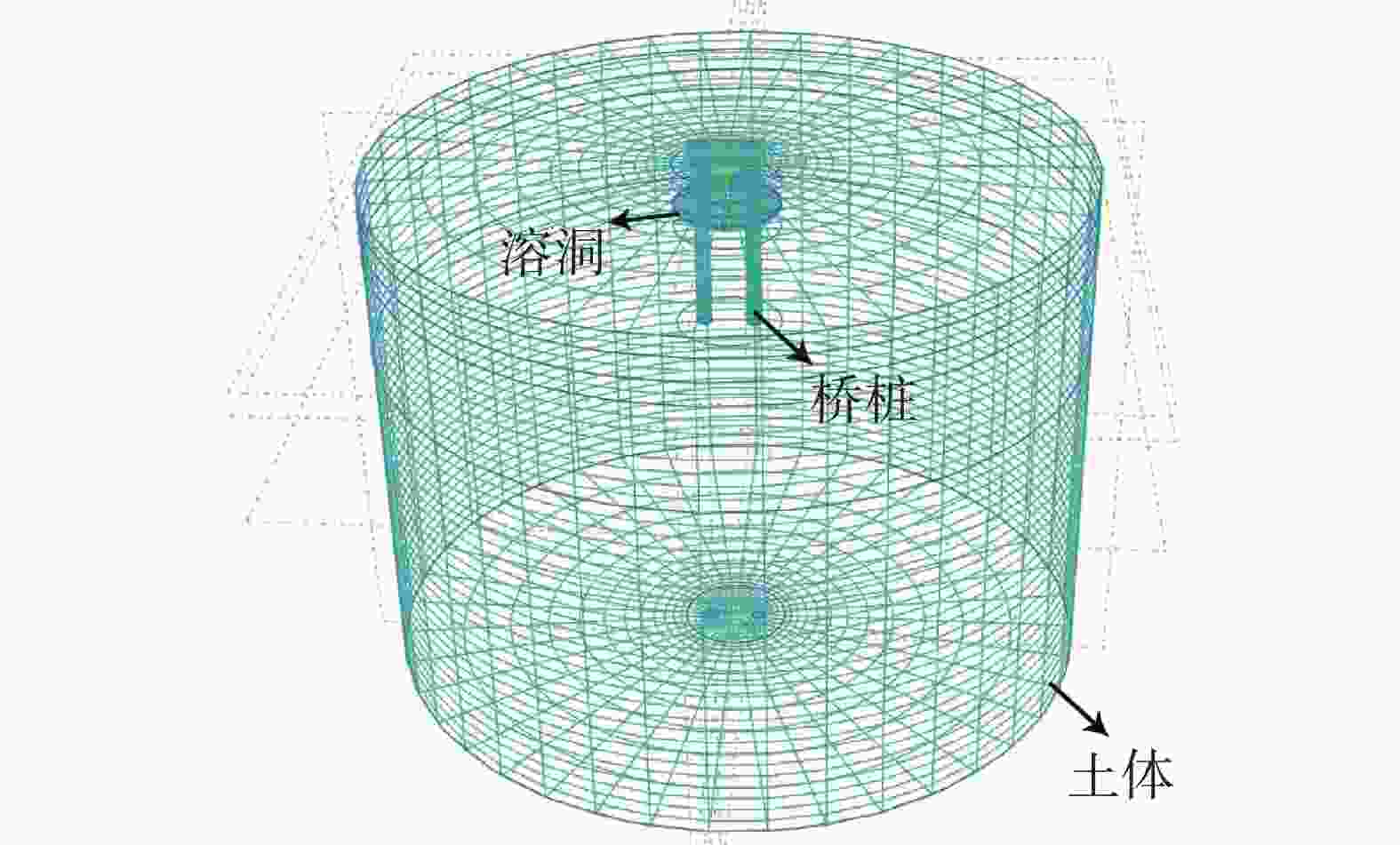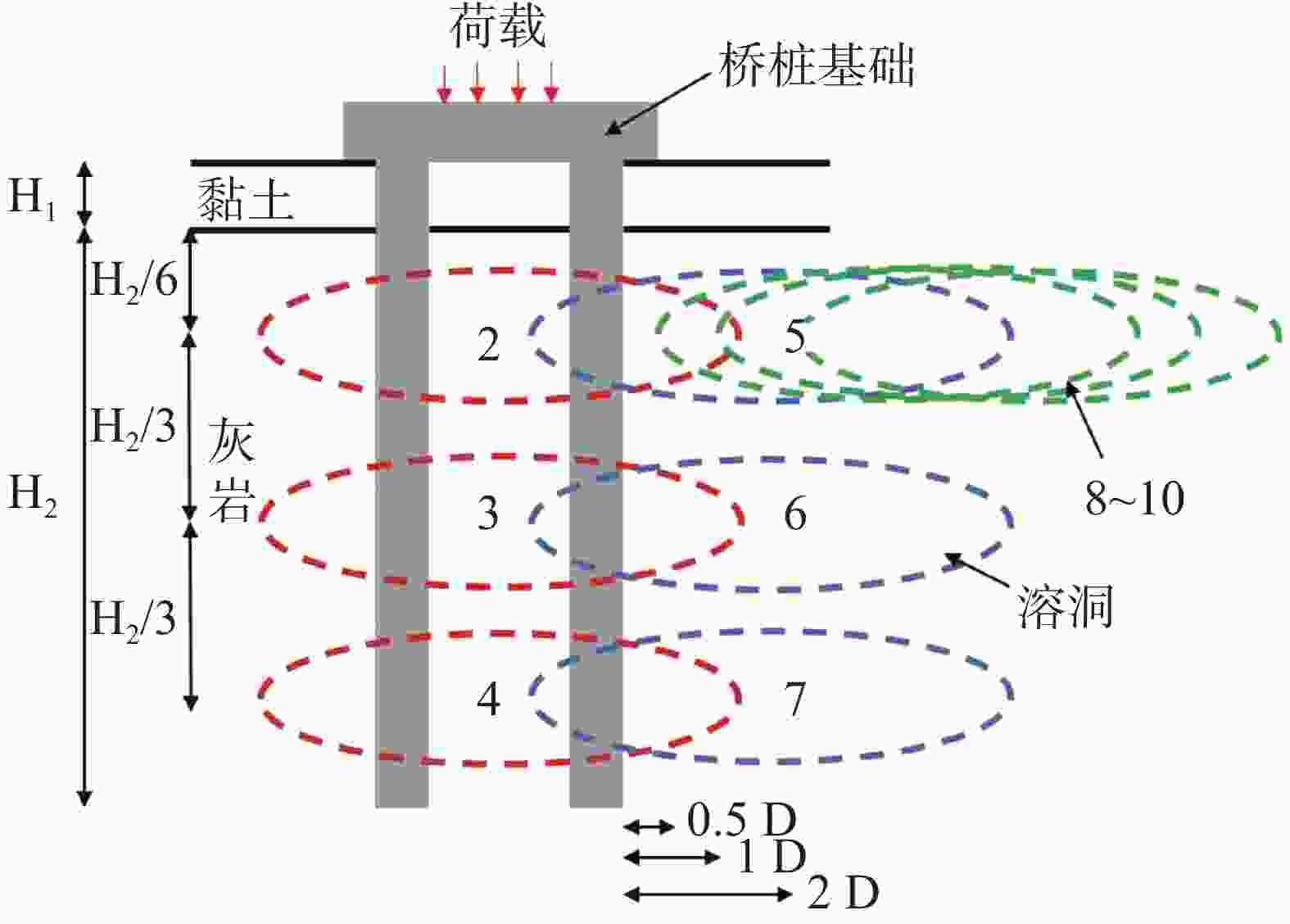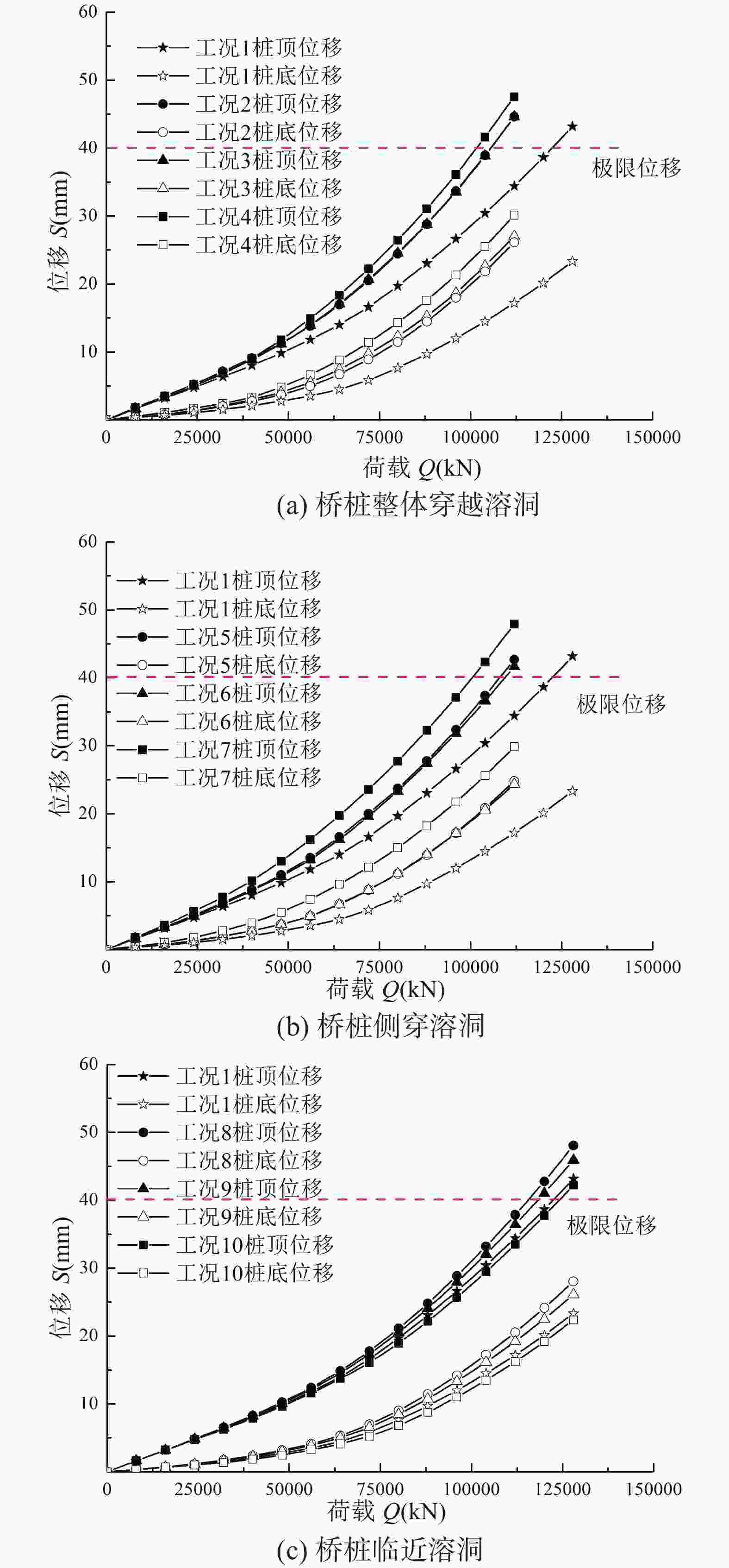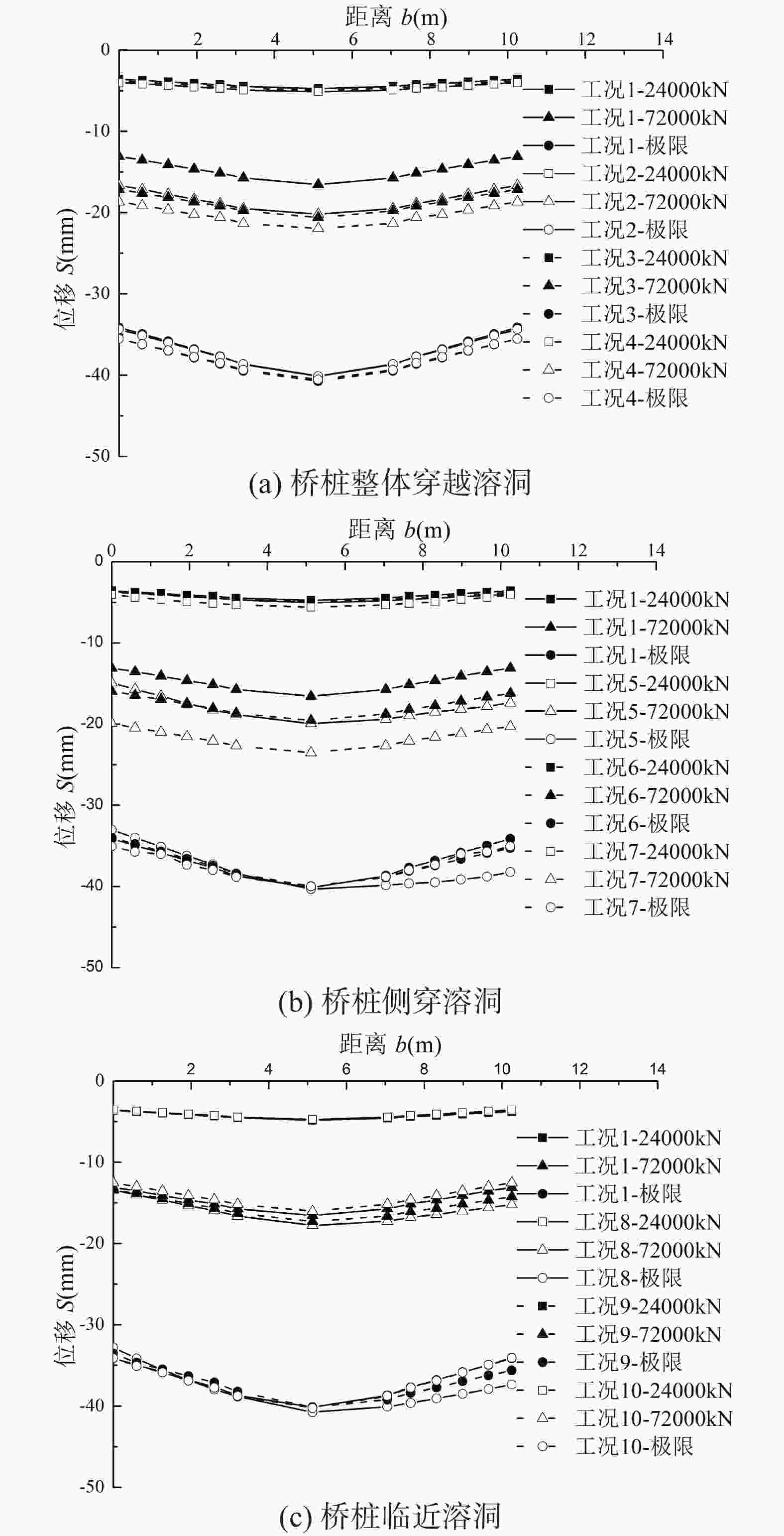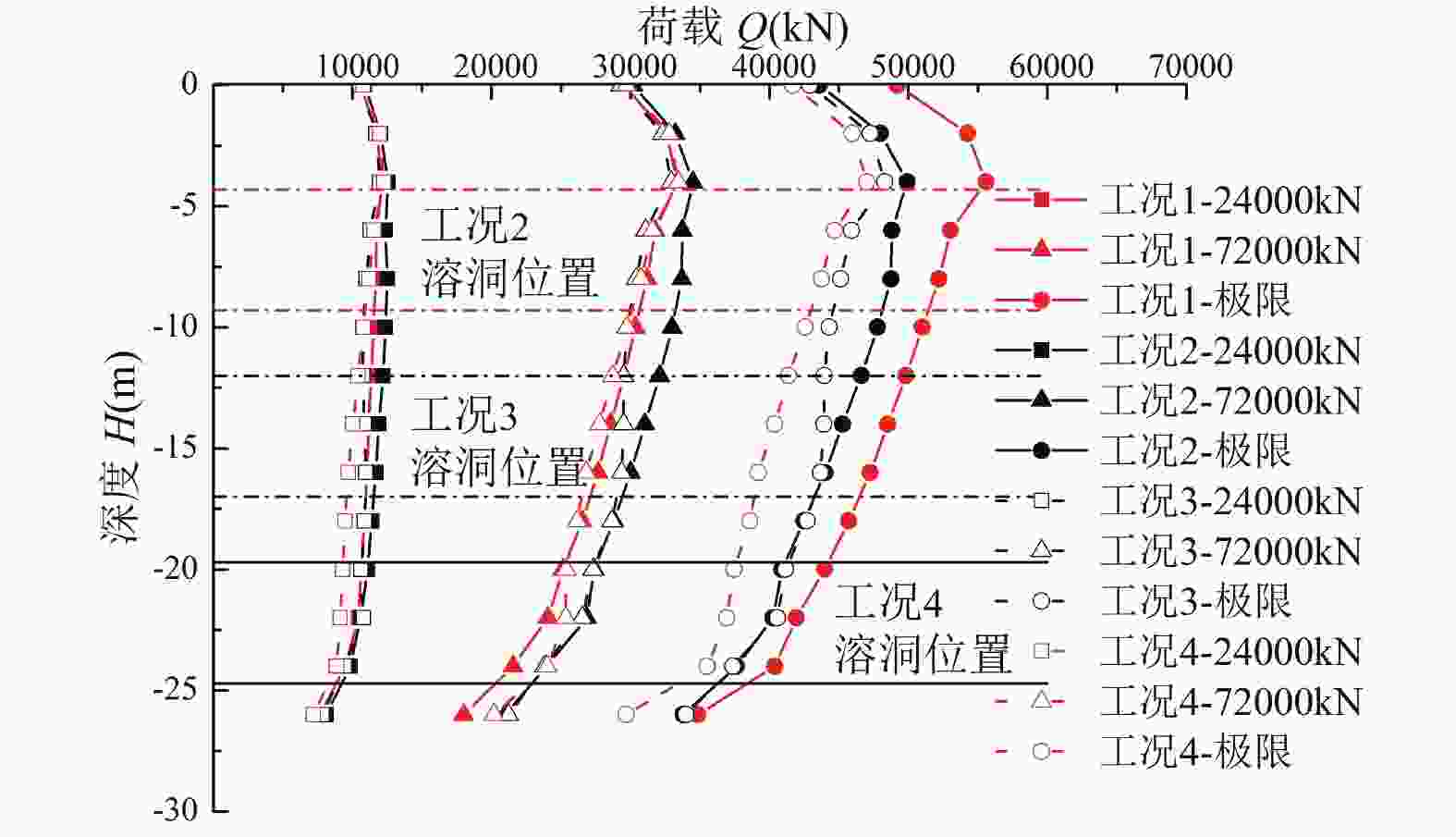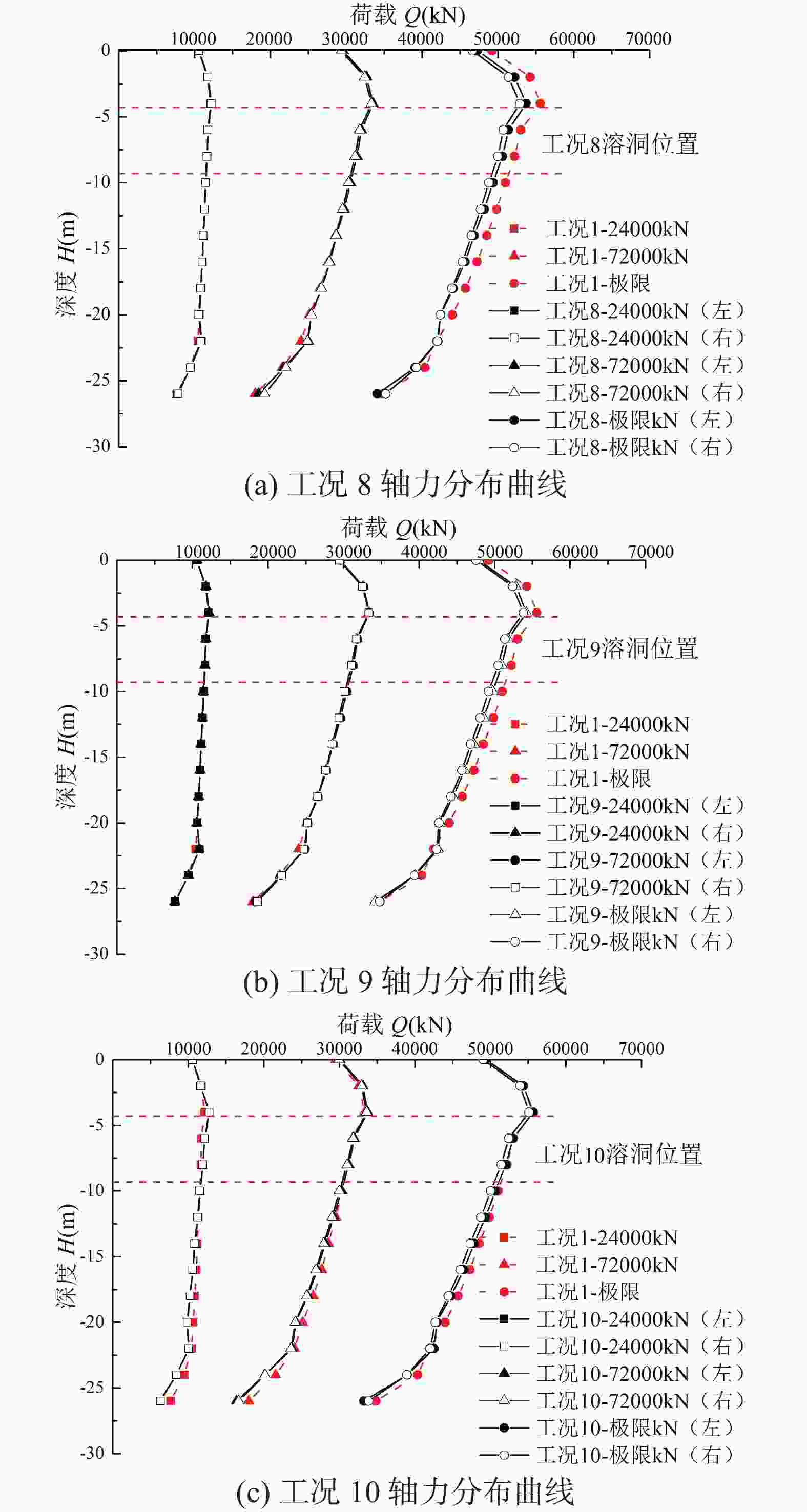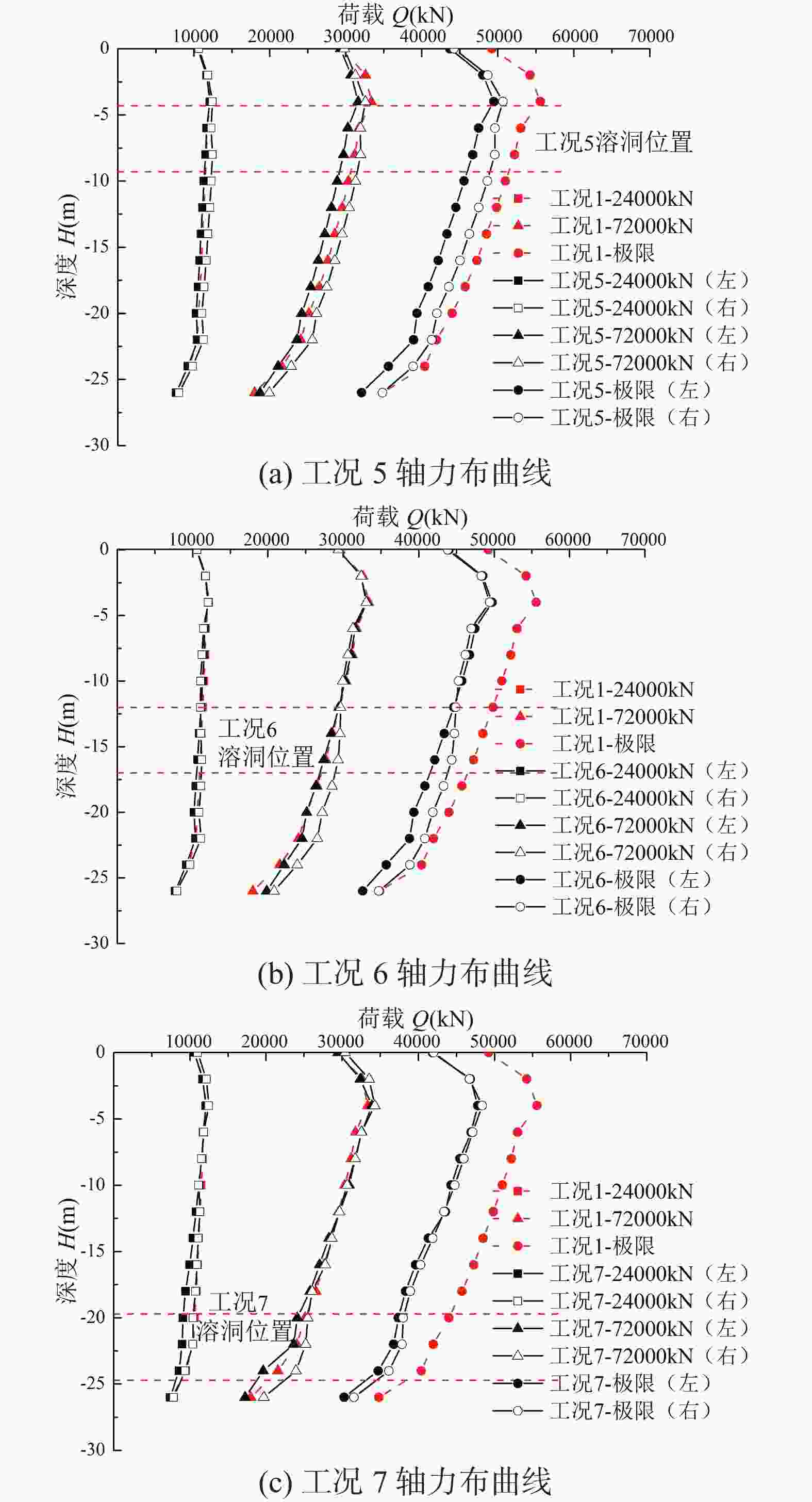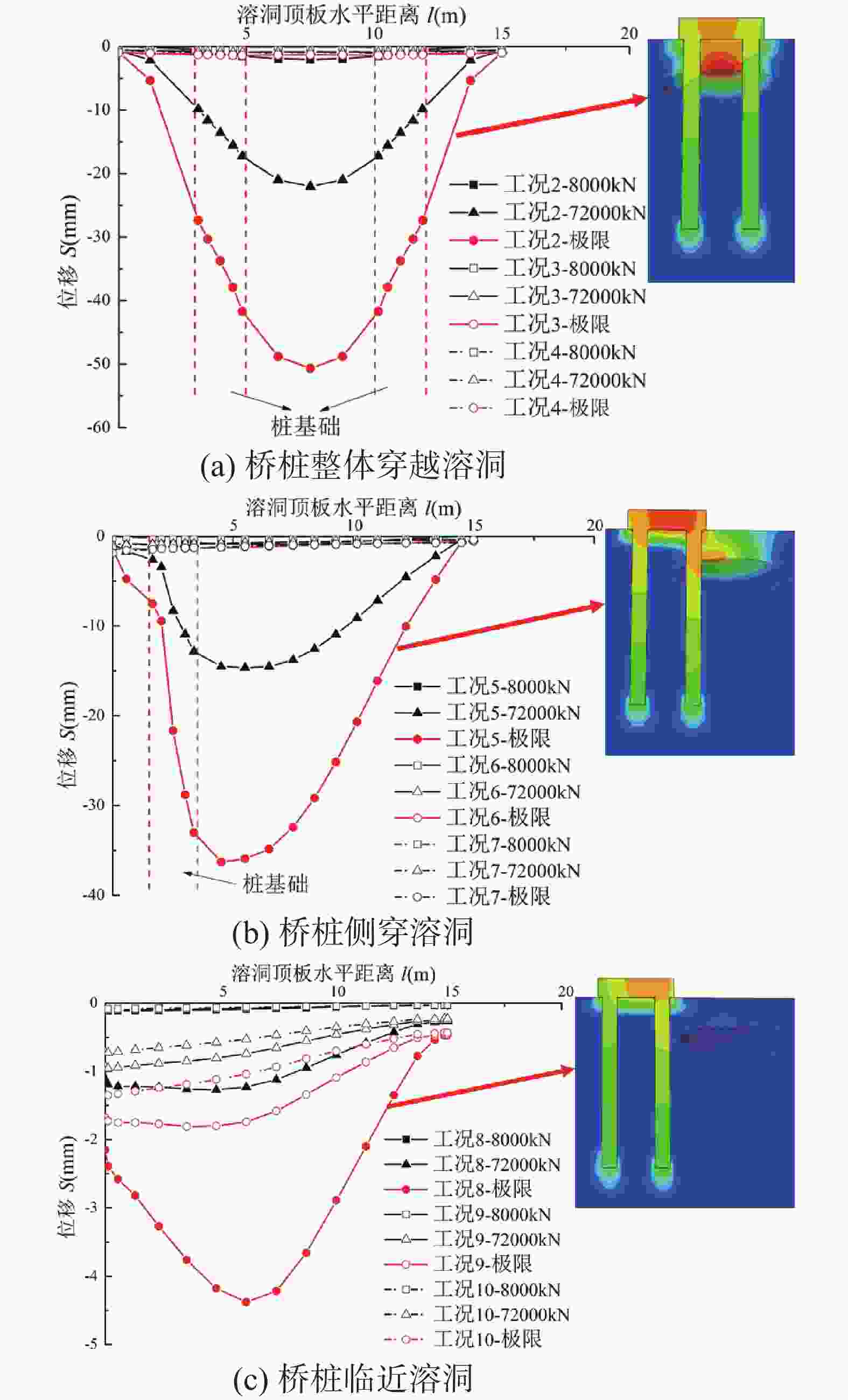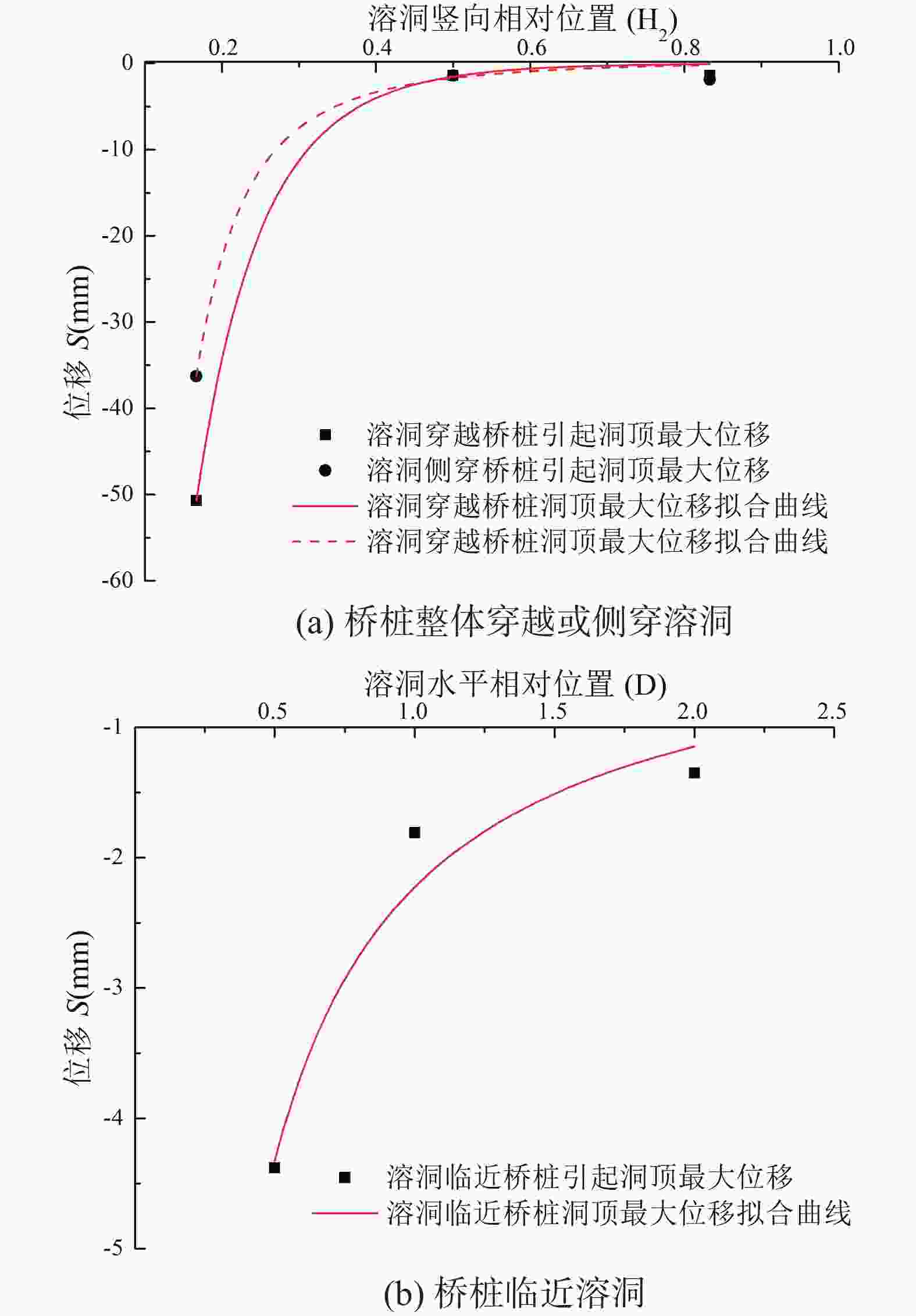Study on bearing characteristics of bridge piles and deformation mechanisms of karst caves in karst area
-
摘要: 为明确岩溶区桥梁建设过程中溶洞对桥桩承载特性的影响机理,以贵州某高速公路项目高架桥桩为依托,采用数值模拟的方法研究桥桩整体穿越溶洞、侧穿溶洞以及临近溶洞情况下桩基承载能力、桩身荷载传递规律以及溶洞稳定性。结果表明:(1)当桥桩穿越溶洞时,桥桩承载能力随溶洞埋深增加而降低,文中工况下承载力最大衰减量为16.5%~17.5%,而当桥桩临近溶洞时,溶洞对桥桩的影响随距离增加而减小,且当水平距离大于2D后(D为桩身直径)影响可忽略不计;(2)当溶洞位于桩身嵌岩段上部且桥桩侧穿溶洞或桥桩临近溶洞不足1D时,桥桩将产生较大差异沉降,进而影响上部结构稳定性;(3)溶洞的存在主要影响桩基临空段侧阻力的发挥,而对其他位置侧阻力的发挥影响不大,且溶洞对端阻力影响程度排序为:桥桩整体穿越溶洞>桥桩侧穿溶洞>桥桩临近溶洞;(4)桥桩整体穿越、侧穿以及临近溶洞引起的溶洞潜在破坏模式分别为顶板拉伸破坏、桩基位置附近剪切破坏以及承台的冲切破坏。Abstract:
Due to the highly undulating terrain, complex geological conditions, and the widespread distribution of karst topography developed with underground karst caves in Southwest China, the construction of bridges and tunnels will inevitably traverse areas that contain these karst caves. The karst effect changes the structure of rock masses, weakening the strength and increasing the permeability of the surrounding soil. In regions where caves are developed, the construction of pile foundations will not only encounter challenges in pile formation but also will experience impacts on the load-bearing capacity of foundations due to the presence of these caves. Prolonged loads can easily result in severe deformations, tilting, or even collapses of the superstructure. To elucidate the impact mechanisms of caves on the bearing characteristics of bridge piles during construction in karst regions, this study focused on viaduct piles from a highway project in Guizhou. Numerical simulations were employed to examine the settlement patterns of piles that completely traversed the cave, those that laterally intersected with the cave, and those that were adjacent to caves. Furthermore, the axial force distribution in the piles and the deformation characteristics of the caves were analyzed, along with the stability of the caves under various working conditions. The research findings indicate as follows, (1) Caves reduce the bearing capacity of bridge piles, although the degree of this effect varies by location. When bridge piles are situated near caves, the influence diminishes with increasing distance, becoming negligible when the horizontal distance exceeds 2D (where D represents the pile diameter). Conversely, when bridge piles pass through caves, their bearing capacity decreases as the burial depth of the caves increases. The maximum impact occurs when the cave is located directly beneath the rock-embedded section of the pile, resulting in a reduction of bearing capacity by approximately 16.5% to 17.5%. Engineering practices should give due consideration to caves near the pile tips. (2) The asymmetric distribution of caves contributes to differential settlement of the foundation. The shallower the cave or the closer it is to the bridge pile, the more significant the impact. Specifically, when the cave is located above the rock-embedded section of the pile or is less than 1D away from the bridge pile, it is necessary to implement reinforcement measures such as backfilling or grouting to prevent excessive differential settlement of the foundation. (3) For end-bearing piles, the influence of the cave on the side resistance of the pile mainly manifests as a loss of side resistance in the exposed section of the pile foundation. The impact of caves on end resistance is ranked as follows: piles fully traversing the cave>piles laterally crossing the cave>piles near the cave. (4) When bridge piles fully traverse the cave, the predominant failure mode of the cave is tensile failure of the roof. When bridge piles laterally cross the cave, shear failure primarily occurs near the pile foundation. When bridge piles are in close proximity to the cave, the potential failure mode is punching shear failure from the foundation. (5) When bridge piles cross the cave, it is crucial to consider the impact of the loads on the stability of the cave and to implement appropriate reinforcement measures. Additionally, when bridge piles are near the cave, caution must be exercised regarding the potential for localized instability of the cave if the distance is too short (<0.5D). -
Key words:
- bridge pile /
- karst cave /
- bearing characteristics /
- stability, karst area
-
表 1 桥桩材料参数
Table 1. Material parameters of bridge piles
名称 密度ρ/g·cm−3 弹性模量E(GPa) 泊松比μ 桥桩 2.5 20 0.15 表 2 岩土体材料参数
Table 2. Material parameters of rock and soil
名称 深度
Hi/m密度
ρ/g·cm−3压缩模量
Es/MPa泊松比
μ粘聚力
c/kPa摩擦角
φ/°黏土 3 1.8 6.6 0.3 25 8 灰岩 77 2.6 2 000 0.25 110 32 表 3 模拟工况信息
Table 3. Information of simulated information
工况 类型 溶洞位置 竖向 水平 1 无溶洞 / / 2 整体穿越溶洞 H2/6 / 3 整体穿越溶洞 H2/2 / 4 整体穿越溶洞 5 H2/6 / 5 侧穿溶洞 H2/6 / 6 侧穿溶洞 H2/2 / 7 侧穿溶洞 5 H2/6 / 8 临近溶洞 H2/6 0.5D 9 临近溶洞 H2/6 1D 10 临近溶洞 H2/6 2D (其中H2/6,H2/2,5H2/6对应实际距离分别为3.8 m,12.5 m,19.2 m)
(H2/6, H2/2, and 5H2/6 correspond to the actual distance of 3.8 m, 12.5m, 19.2 m, respectively)表 4 桥桩极限荷载与位移
Table 4. Ultimate load and displacement of bridge piles
工况 极限荷
载/kN承载力衰
减系数 /%桩顶位
移/mm桩底位
移/mm桩身压缩
量/mm1 121 941.8 / 40 20.09 19.91 2 105 271.0 13.67 40 22.46 17.54 3 105 760.1 13.27 40 23.56 16.44 4 101 825.6 16.50 40 24.40 15.60 5 107 852.9 11.55 40 22.67 17.33 6 109 358.8 10.32 40 23.06 16.94 7 100 505.5 17.58 40 23.89 16.11 8 115 146.8 5.57 40 21.88 18.12 9 117 801.9 3.39 40 21.57 18.43 10 123 774.4 −1.50 40 20.63 19.37 -
[1] 郭静芸, 李守定, 李滨, 李晓, 毕鑫涛, 方然可. 岩溶山区崩滑灾害变形破坏地质模式分类[J]. 中国岩溶, 2020, 39(4):478-491.GUO Jingyun, LI Shouding, LI Bin, LI Xiao, BI Xintao, FANG Ranke. Geological models classification of deformation and failures for collapses and landslides in karst mountainous areas[J]. Carsologica Sinica, 2020, 39(4): 478-491. [2] 李强, 秦余顺. 中老铁路桥梁桩基岩溶处理施工技术研究[J]. 中国岩溶, 2019, 38(4):607-611. doi: 10.11932/karst20190420LI Qiang, QIN Yushun. Technologies to deal with karst caves beneath pile foundation of the big bridge on the Laos-China railway[J]. Carsologica Sinica, 2019, 38(4): 607-611. doi: 10.11932/karst20190420 [3] 王伟. 岩溶区溶洞型桩基承载机理及溶腔整治技术研究[D]. 北京:北京交通大学, 2019.WANG Wei. Study on bearing mechanism of pile penetrating karst caves and cavern treatment technology in karst Area[D]. Beijing: Beijing Jiaotong University, 2019. [4] 石振明, 刘鎏, 彭铭, 陶凤娟, 刘春生. 钻孔灌注桩桩底溶洞声呐探测方法及应用研究[J]. 岩石力学与工程学报, 2016, 35(1):177-186.SHI Zhenming, LIU Liu, PENG Ming, TAO Fengjuan, LIU Chunsheng. A sonar detection technology for karst cavities under bored piles and its application[J]. Chinese Journal of Rock Mechanics and Engineering, 2016, 35(1): 177-186. [5] 赵杰. 大直径桩桩位岩溶管波探测技术研究[D]. 青岛:中国海洋大学, 2012.ZHAO Jie. Research of tube wave prospecting karst development under large diameter pile[D]. Qingdao: Ocean University of China, 2012. [6] 张健. 顶板倾斜隐伏溶洞区桩基承载机理与稳定性评价研究[D]. 济南:山东大学, 2019.ZHANG Jian. Study on bearing mechanism and stability evaluation of pile foundation in karst cave areas with inclined roof[D]. Jinan: Shandong University, 2019. [7] 冯明伟. 岩溶区桥梁桩基承载机理及试验研究[D]. 长沙:湖南大学, 2014.FENG Mingwei. The bearing mechanism and experimental research of bridge pile foundation in karst area[D]. Changsha: Hunan University, 2014. [8] 袁维, 刘尚各, 聂庆科, 王伟. 基于冲切破坏模式的嵌岩桩桩端溶洞顶板临界厚度确定方法研究[J]. 岩土力学, 2019, 40(7):2789-2798.YUAN Wei, LIU Shangge, NIE Qingke, WANG Wei. An approach for determining the critical thickness of the karst cave roof at the bottom of socketed pile based on punch failure mode[J]. Rock and soil mechanics, 2019, 40(7): 2789-2798. [9] 黄生根, 梅世龙, 龚维明. 南盘江特大桥岩溶桩基承载特性的试验研究[J]. 岩石力学与工程学报, 2004, 23(5):809-813. doi: 10.3321/j.issn:1000-6915.2004.05.019HUANG Shenggen, MEI Shilong, GONG Weiming. Testing study on bearing behavior of piles for Nanpan river great bridge in kast area[J]. Chinese Journal of Rock Mechanics and Engineering, 2004, 23(5): 809-813. doi: 10.3321/j.issn:1000-6915.2004.05.019 [10] Wang P, Ding H, Zhang P. Influence of karst caves at pile side on the bearing capacity of super-long pile foundation[J]. Mathematical Problems in Engineering, 2020, 2020(2): 1-13. [11] Zheng C B, Xu J. Discussion on treatment technology of reinforcement pile in karst area[J]. Applied Mechanics & Materials, 2014, 580-583: 52-55. [12] Zhao M H, Zhu Z R, Huang M H, Yang C W, Xu Z J. Study on thickness of safety for cave roofs suffered bending failure in karst areas[J]. Rock and Soil Mechanics, 2018, 39(11): 4201-4209. [13] 刘士锋. 桩筏基础与地基土共同作用的三维数值模拟研究[D]. 昆明:昆明理工大学, 2007.LIU Shifeng. The study on the interaction of stake-raft foundation and soil[D]. Kunming: Kunming University of Science and Technology, 2007. [14] 郑刚, 张立明, 王琦. 超长桩荷载传递机理有限元分析[J]. 天津大学学报, 2012, 45(11):945-952.ZHENG Gang, ZHANG Liming, WANG Qi. Finite element analysis on load transfer mechanism of overlength piles[J]. Journal of Tianjin University, 2012, 45(11): 945-952. [15] 郭中华, 原法芳, 王华, 梁斌. 海上淤泥区斜拉桥超长桩基自平衡法承载力试验研究[J]. 水利水电技术, 2020, 51(8):181-190.GUO Zhonghua, YUAN Fafang, WANG Hua, LIANG Bin. Self-balancing method-based experimental study on bearing capacity of super-long pile foundation for cable-stayed bridge in marine silt area[J]. Water Resources and Hydropower Engineering, 2020, 51(8):181-190. [16] 中华人民共和国建设部. JGJ106-2014 建筑基桩检测技术规范[S]. 北京:中国建筑工业出版社, 2014.Ministry of Construction of the People's Republic of China. JGJ106-2014 Technical code for testing building foundation piles[S]. Beijing: China Architecture and Building Press, 2014. [17] 中国人民共和国交通运输部. JTGTF50-2011-1 公路桥涵施工技术规范[S]. 北京:人民交通出版社, 2011.Ministry of Transport of the People's Republic of China. JTGTF50-2011-1 Technical specification for construction of highway bridges and culvert[S]. Beijing: China Communications Press, 2011. [18] 宋战平, 肖珂辉, 杨腾添. 渗透压力作用下灰岩单轴压缩变形特性研究[J]. 西安建筑科技大学学报(自然科学版), 2019, 51(5):649-653, 703.SONG Zhanping, XIAO Kehui, YANG Tengtian. Study on deformation characteristics of limestone under uniaxial compression considering seepage pressure[J]. Journal of Xi'an University of Architecture & Technology (Natural Science Edition), 2019, 51(5): 649-653, 703. [19] 杨冲, 左双英, 张元帅, 蒲泉, 王露, 何兴. 水平层理棱柱形灰岩抗压强度尺寸效应[J]. 科学技术与工程, 2019, 19(26):325-331. doi: 10.3969/j.issn.1671-1815.2019.26.051YANG Chong, ZUO Shuangying, ZHANG Yuanshuai, PU Quan, WANG Lu, HE Xing. Compressive strength size effect of horizontal layered prismatic limestone[J]. Science Technology and Engineering, 2019, 19(26): 325-331. doi: 10.3969/j.issn.1671-1815.2019.26.051 -





 下载:
下载:
